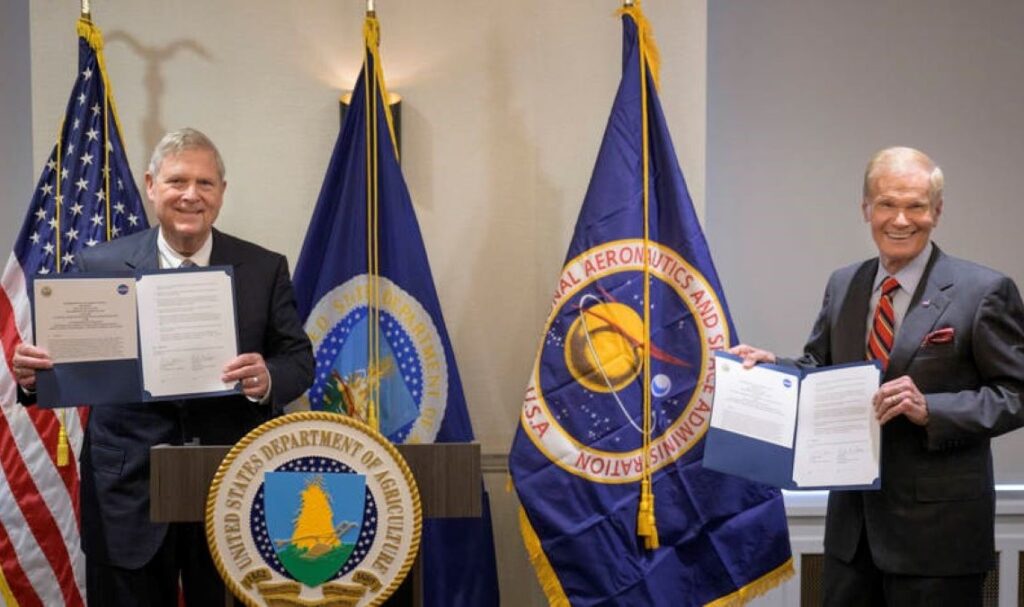The MoU signed between NASA and USDA marks a significant milestone in strengthening the partnership between these two agencies and preparing the next generation of professionals in STEM and agriculture.
The collaboration between NASA and the U.S. Department of Agriculture (USDA) has been solidified through the signing of an MoU. This agreement aims to enhance joint efforts in agricultural and Earth science research, technological advancements, agricultural management, and the utilization of scientific data and models in making agricultural decisions.
The partnership between NASA and the USDA seeks to inspire American youth to pursue careers in STEM and agriculture through education, communication, and outreach activities. Leveraging NASA’s Bridge Program, which focuses on establishing partnerships with higher-education institutions, including Tribal and Minority Serving Institutions, and the USDA’s NextGen program, which allocates USD 262.5 million to support diverse food and agriculture professionals, the collaboration aims to empower future generations and promote their involvement in the agriculture industry.
By equipping farmers with essential data and knowledge, the commitment between NASA and the USDA aims to strengthen America’s agriculture industry. NASA’s Earth observation data plays a crucial role in developing climate-resilient food systems, especially in the face of climate change. This data will aid farmers in adopting sustainable farming and aquaculture practices.
The collaboration will explore opportunities to improve crop performance to meet both Earth-based and space-related objectives. This includes supporting NASA’s Artemis program, which seeks to land the first woman and the first person of color on the Moon and establish long-term lunar exploration as a preparation for human exploration of Mars.
U.S. Secretary of Agriculture Tom Vilsack expressed enthusiasm for strengthening the partnership, recognizing the interconnectedness of global food security, climate change, and space. The collaboration between the USDA and NASA will drive innovation, research, and workforce development to address the most pressing challenges faced by our planet.
The cooperation between the USDA and NASA in space exploration includes plant-related research conducted on the International Space Station and other space and ground platforms. These initiatives have led to groundbreaking methods that enhance American and global agriculture, preserve the environment, and promote human health.
The MoU builds upon the ongoing partnership between the USDA and NASA, which began in 2015. Some recent collaborative initiatives include:
- Partnership with North Carolina Agricultural and Technical State University: In 2022, the USDA’s National Institute of Food and Agriculture (NIFA) collaborated with NASA to send 16 young individuals to NASA Space Camp. This program, held at the U.S. Space & Rocket Center in Huntsville, Alabama, provides participants with opportunities to develop skills in robotics, teamwork, leadership, critical thinking, and experience practical applications of STEM.
- Creation of the Crop-CASMA Tool: The USDA’s National Agricultural Statistics Service (NASS) and NASA jointly developed the Crop-CASMA tool, a free online resource. This tool assists farmers and researchers in utilizing soil data to track droughts and floods, plan crop planting, and forecast agricultural yields. The USDA incorporates this data into NASS’s weekly crop progress reports, aiding farmers and farm managers in making operational decisions and strategic plans.
- Advancements in Plant Health Monitoring: Scientists from the USDA’s Agricultural Research Service (ARS) and NASA are collaborating to develop a hyperspectral imaging system. This system will enable astronauts to monitor the health of plants grown in plant growth chambers during space missions, ensuring the safety and quality of pick-and-eat crops, such as fresh salad greens. Additionally, ARS and NASA are exploring sustainable methods of cultivating fresh food during space travel, including continuous flowering and production of plants.

